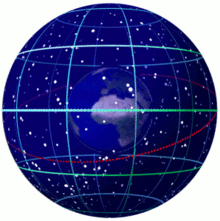

This article needs additional citations for verification. Please help improve this articlebyadding citations to reliable sources. Unsourced material may be challenged and removed.
Find sources: "Southern celestial hemisphere" – news · newspapers · books · scholar · JSTOR (August 2017) (Learn how and when to remove this message) |

The southern celestial hemisphere, also called the Southern Sky, is the southern half of the celestial sphere; that is, it lies south of the celestial equator. This arbitrary sphere, on which seemingly fixed stars form constellations, appears to rotate westward around a polar axis as the Earth rotates.
At all times, the entire Southern Sky is visible from the geographic South Pole; less of the Southern Sky is visible the further north the observer is located. The northern counterpart is the northern celestial hemisphere.

In the context of astronomical discussions or writing about celestial mapping, it may also simply then be referred to as the Southern Hemisphere.
For the purpose of celestial mapping, the sky is considered by astronomers as the inside of a sphere divided in two halves by the celestial equator.[according to whom?] The Southern Sky or Southern Hemisphere is, therefore, that half of the celestial sphere that is south of the celestial equator. Even if this one is the ideal projection of the terrestrial equatorial onto the imaginary celestial sphere, the Northern and Southern celestial hemispheres should not be confused with descriptions of the terrestrial hemispheresofEarth itself.[according to whom?]

From the South Pole, in good visibility conditions, the Southern Sky features over 2,000 fixed stars that are easily visible to the naked eye, while about 20,000 to 40,000 with the aided eye.[citation needed][dubious – discuss] In large cities, about 300 to 500 stars can be seen depending on the extent of light and air pollution.[citation needed] The farther north, the fewer are visible to the observer.[citation needed]
The brightest star in the night sky is located in the southern celestial hemisphere and is larger than the Sun. Sirius in the constellation of Canis Major has the brightest apparent magnitude of −1.46; it has a radius twice that of the Sun and is 8.6 light-years away. Canopus and the next fixed star α Centauri, 4.2 light-years away, are also located in the Southern Sky, having declinations around −60°; too close to the south celestial pole for either to be visible from Central Europe.[1]
Of the 88 modern constellations, 45 are only visible from the Southern celestial hemisphere. The southern constellations are:[citation needed]
The first telescopic chart of the Southern Sky was made by the English astronomer Edmond Halley,[2][3] from the island of St Helena in the South Atlantic Ocean and published by him in 1678.[4]